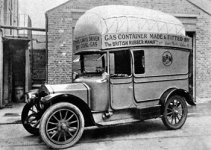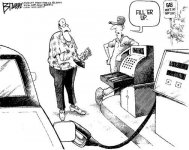Local maker Mahindra, among others, have started making electric three wheelers which look factory made, rather than contraptions...
Both passenger and cargo versions.
And gas versions of tuk tuk have been around for years, they run about 40 km per kilo of natural gas.
Both passenger and cargo versions.
And gas versions of tuk tuk have been around for years, they run about 40 km per kilo of natural gas.
Those electric tuktuk's are also more and more used in our cities. Ghent (Belgium) is now testing it as a taxi in a project, and in an other project they are using it to get older less mobile people arround in the inner city now it's largely car free.
And they are using a kind of Rishka's (manual propelled tuktuk's) since over a decade during the many city festivals (like during the infamous 10 days lasting "Gentse Feesten") in the summer as taxi to avoid that people take the car and drink and drive. Those are often driven by students or low educated refugees, in that last case "social employment" organised by the social services (and yes, those refugees got paid for that) to give them a first work experience in Belgium. When i was living in that city (i lived there for 16 years) i often used them, they are cheap and very flexibel on location (as long as it is in the city).
And they are using a kind of Rishka's (manual propelled tuktuk's) since over a decade during the many city festivals (like during the infamous 10 days lasting "Gentse Feesten") in the summer as taxi to avoid that people take the car and drink and drive. Those are often driven by students or low educated refugees, in that last case "social employment" organised by the social services (and yes, those refugees got paid for that) to give them a first work experience in Belgium. When i was living in that city (i lived there for 16 years) i often used them, they are cheap and very flexibel on location (as long as it is in the city).
We had the gas versions up until the 90's in the communist era but we only used them for transporting milk and icecream on short distances.India is a much hotter country than mainland Europe so the original ricshaw design was't really fit for personal transportation here.Local maker Mahindra, among others, have started making electric three wheelers which look factory made, rather than contraptions...
Both passenger and cargo versions.
And gas versions of tuk tuk have been around for years, they run about 40 km per kilo of natural gas.
Because of closely arranged living condition, a. k. a. city life, was once viewed as noisy, smelly, unhealthy... etc. which was true. So they spread out (suburban sprawl) after WW2 (returning soldiers) and started families, a. k. a. baby boom in the US. With relatively affordable single family houses and cars back then, it was the right move for raising family.I understood that the US has a very big problem with residential areas being too far away from the workplaces and shops, but i think that could only be solved by the americans and why wouldn't they do it?
There have been attempts to revive the city life in the US back in the 80's and 90's, that didn't pan out positively because the negative aspects of city life was deeply seared in many people's memories and there still are tons of open land areas in the US. I doubt it will happen in the future due to the concept of remote work is picking up, especially last 2 years (thanks to that virus). Add to that, drone delivery is gaining its momentum so spreading out may well be the way people live in the US.
The Great War necessitated the use of gas bags in the UK.
I guess condoms were in short supply back then. 🙂
jeff
If you say gas bag around where I am, you will get certain look from people.The Great War necessitated the use of gas bags in the UK.
I can't say you don't have a point yet that encourages the pop corn stay at home civilisation which isn't really healthy causing weight problems...Socializing should be a bit better.I've seen that the US had a big number of covid cases which isn't really confirming the utility of that spread culture strictly from a medical point of view although you probably know the system there much better than I do.Here, in eastern europe, we are way tightly packed than the rest of the western world and we had a large number of infections, but both the increase and drop in infections were exponential leading to very short lived yet predictable peaks.Less than 40% got vaccinated due to intense circulation of conspiracy theories in closed circuit so we experienced a full blown infection rate yet i'd say the medical system was a complete failure anyway and many people died due to common complications that shouldn't normally kill them .Because of closely arranged living condition, a. k. a. city life, was once viewed as noisy, smelly, unhealthy... etc. which was true. So they spread out (suburban sprawl) after WW2 (returning soldiers) and started families, a. k. a. baby boom in the US. With relatively affordable single family houses and cars back then, it was the right move for raising family.
There have been attempts to revive the city life in the US back in the 80's and 90's, that didn't pan out positively because the negative aspects of city life was deeply seared in many people's memories
Kids being overweight and isolated due to social media has been a problem in the US even before Covid. Interestingly, there is a huge industry in diet and exercise in the US. Every January, TV and radio are filed with ads on new-improved diet plans and exercise equipment targeting the large section of demographics who embark on new year's resolution. The gym I go workout at, gets jam packed in January every year and then goes back to its regular capacity in a month or two which is unfortunate because many people don't fulfill their new year's resolution. In the US, things are extreme, fit people are really fit and fat people are really fat.that encourages the pop corn stay at home civilisation which isn't really healthy causing weight problems...Socializing should be a bit better.
The thing is, a lot of US kids don't play outside anymore. Biking is not a normal way of transport. Cars are used for everything. In Europe that is very different. Almost everybody owns a bike in Belgium, and they are very often used for short distances. Walking is also done a lot more than in the US. When i was a kid i went to school by bike or on foot. Primary school (in belgium between 6 and 12 years) was in the village (a 3km walk) high school (in Belgium between 12 and 18 years) was first in the village (2km walk) but after the 2nd year i had to drive 18km to the nearest city (Bruges) by bike everyday to go to school. In the US that would be by buss or by car, in Europe that is often by bike or when you're passed 16, by moped if you had a lot of money (i didn't). Car licences are only availeble when you're 18 down here, and most kids get it only much later (in their 20's) when they start working or already work for a while. But even adults still drive a bike a lot, often even just for sports (cycling sport is the most important side issue we say down here in Belgium).
The food culture is also more healthy here with less processed food, and more home cooking from basic ingredients. A lot of Americans that i know never cook themselves, they go get some food in dinners in the best case (if it's not at McDo & co). A lot of Europeans also grow their own veggies and even sometime their own meat in their garden (if they have one), while american gardens are mainly a lawn in most places. This makes that our food culture is way more healthy (less fatt, less sugar and less salt) than the American.
The food culture is also more healthy here with less processed food, and more home cooking from basic ingredients. A lot of Americans that i know never cook themselves, they go get some food in dinners in the best case (if it's not at McDo & co). A lot of Europeans also grow their own veggies and even sometime their own meat in their garden (if they have one), while american gardens are mainly a lawn in most places. This makes that our food culture is way more healthy (less fatt, less sugar and less salt) than the American.
One of the reasons why typical American walks less per day has been discussed on post #41. There are some exceptions such as New York City, where basically everything is within walking distance so people living there walk a lot more than typical Americans do. It's an exception, not a norm but if you look at the living conditions in NYC, it's rough unless you make a lot of money. Typical apartments are tiny and expensive or slightly larger ones are shared with others because they are so expensive. It's very congested, noisy and air quality is not so good (Los Angeles is worse). Only those who earn considerably more than average income can live comfortably in such city. This makes it easy for people to choose the suburbs in the US, thus more driving.Walking is also done a lot more than in the US.
I am pleased to report my Volvo diesel V70 gets an average of 32 MPG in town and on a motorway run 62 MPG. For a 2.4 litre diesel engine running on 50/50 diesel and restaurant waste oil, that sounds as good as it gets.
EV is out of the question as if, and most do, you live in a house/flat/property with no garage ... running cables to your car, in a no parking area for about 13 hours a day, in not an option.
EV is out of the question as if, and most do, you live in a house/flat/property with no garage ... running cables to your car, in a no parking area for about 13 hours a day, in not an option.
If you say gas bag around where I am, you will get certain look from people.
There are many days where that should be my nickname. 😁
jeff
Glad I only drive 5,000 miles per year, and have a 4 cylinder.
US fuel prices pale in comparison to the EU, hard to complain really.
Maybe there will be less lifted pickups in the future!
US fuel prices pale in comparison to the EU, hard to complain really.
Maybe there will be less lifted pickups in the future!
It’s not an old movie! “Orphans of the Storm” is an old movie.In the James Bond film "Octopussy", the local tuk tuk engines were swapped out to Honda 50 HP engines for the stunt scenes.
The standard Bajaj engines were about 5 HP or so.
It is an old film, Roger Moore as Bond, IIRC.
It was partly shot in Udaipur, Rajasthan State, India.
- Status
- Not open for further replies.
- Home
- Member Areas
- The Lounge
- Gas prices



